Alongside trilobites, ammonites are far and away the most popular group of prehistoric invertebrates. These shelled cephalopods belong to the broader Ammonoidea, which evolved over 400 million years ago during the Devonian. Keep in mind that not all ammonoids are ammonites and actual ammonites from the Ammonitida clade lived during the Jurassic and Cretaceous, a time during which they flourished. Their fossils are abundant around the world and easy to obtain. They are also important index species, allowing paleontologists to determine a site’s age just by their presence there. Ammonites were similar to Nautiloids in having a shell but were more closely related to Coleoidea, the squids, cuttlefish, and octopuses. Nautiloids pre-date ammonoids, first appearing in the Cambrian, 495 million years ago.

Invertebrate popularity must be measured differently from vertebrate popularity, and much differently from dinosaur popularity. Although they are frequently depicted in paleo-art, worn as jewelry, sold in gift shops, and included in fossil dig kits they still aren’t represented well as toys or figurines. A few ammonites have shown up over the years, notably those by Bullyland, Safari, and Kaiyodo. For 2020 CollectA produced an ammonite of their own, along with a belemnite and Orthoceras. Plus a Nautilus for their extant animal line. Another ammonite is set to be released in 2021 and a few exist as mini-figures as well, so CollectA has brought much needed representation to extinct cephalopods recently. Hopefully the trend continues.
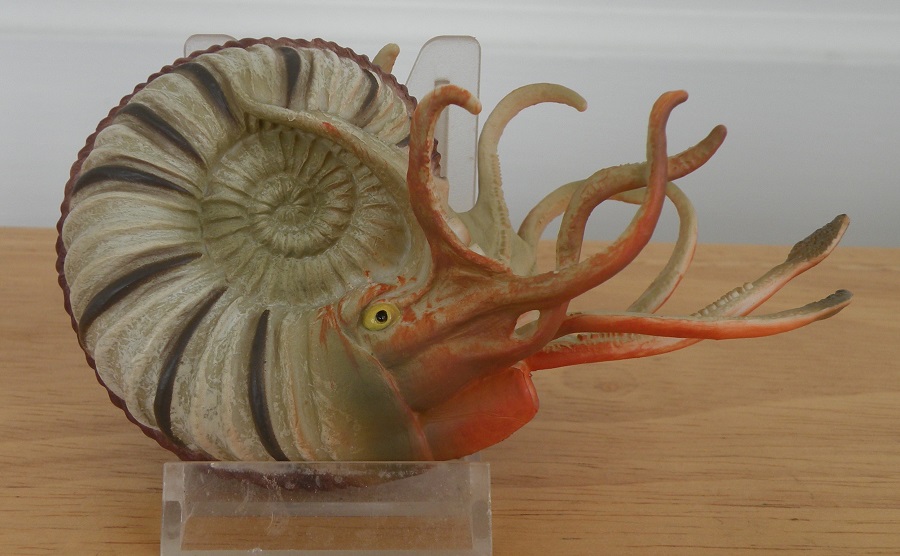
Most ammonite toys are simply labeled “ammonite” without anything more specific. This is about as vague as labeling a toy Tyrannosaurus rex as a “dinosaur”. Although CollectA didn’t bother to identify their recent belemnite they did indeed identify their ammonite to the genus level. Pleuroceras was a genus of ammonite that includes 3 species that lived during the early Jurassic. Pleuroceras has a planulate (flattened) shell, a quadrate (square/rectangular) whorl section, and strong radial ribs ending in tubercles.
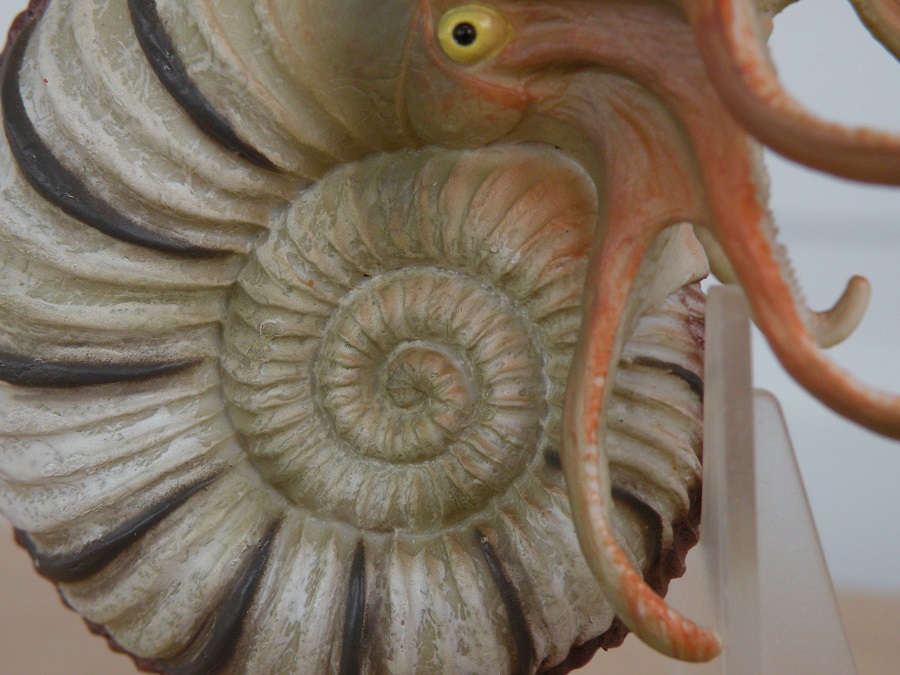
Pleuroceras ammonites seem popular because the Safari ammonite and one of the Bullyland ammonites, although not identified as such, also appear to be Pleuroceras. Why this genus? I couldn’t say, but it does have a distinctive and visually appealing shell.
The CollectA ammonite was sculpted by German artist Matthias Geiger and Pleuroceras ammonites are indeed found in Germany, as well as elsewhere in Europe and Canada. Although ammonite shells are commonly fossilized the soft body parts are not, and thus far the only preserved soft parts have been some digestive organs and possibly an ink sac.
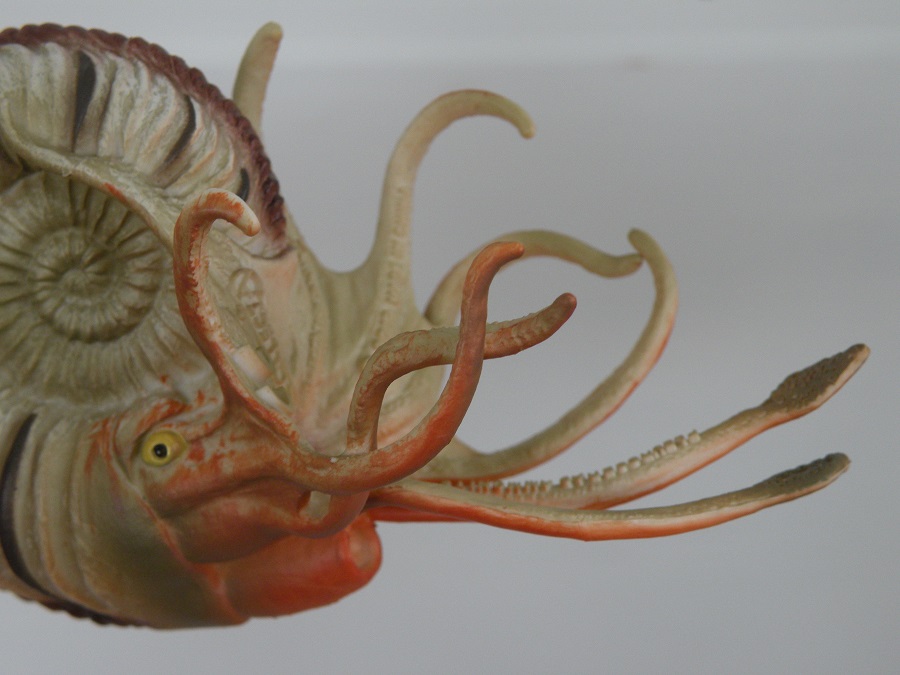
Despite popular nomenclature, not all cephalopod appendages are tentacles. Cephalopods have arms and/or tentacles, but the arms and tentacles are two different parts with different purposes. With few exceptions, octopuses have 8 arms but no tentacles while squids and cuttlefish have 8 arms and two tentacles. The arms are shorter than the tentacles and usually possess suckers whereas the longer tentacles only have suckers on their clubs. The nautilus on the other hand can have up to 90 arms, no suckers, and no tentacles.
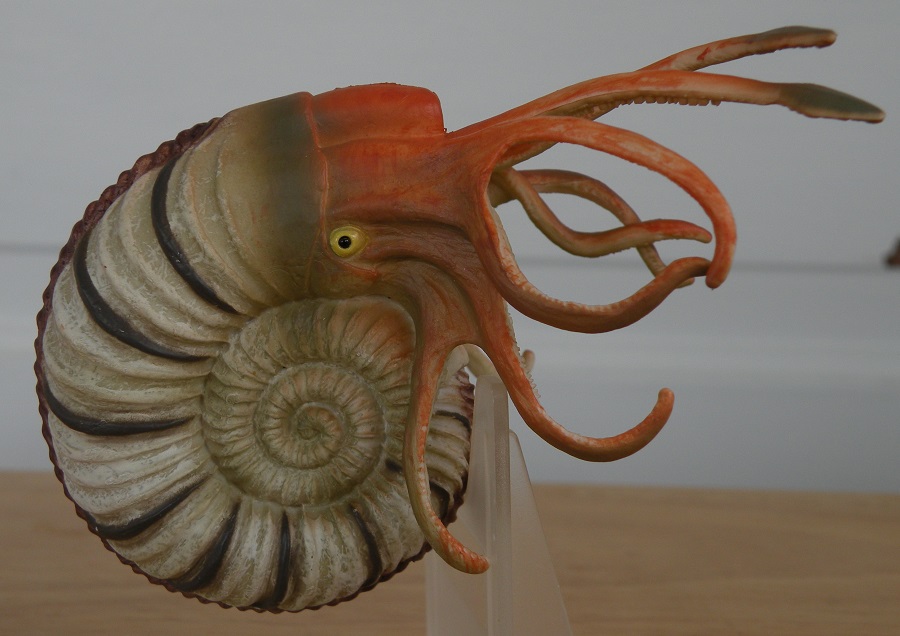
So what about ammonites? We know that they were more closely related to Coleoids than to Nautiloids so their arm structure would have likely been more like the former. But did they have tentacles? Well, this ammonite does, and so does the Safari, but the Bullyland ammonites do not. And that seems to be the case for paleo-art reconstructions too, some have them and some do not, and I guess it could go either way.
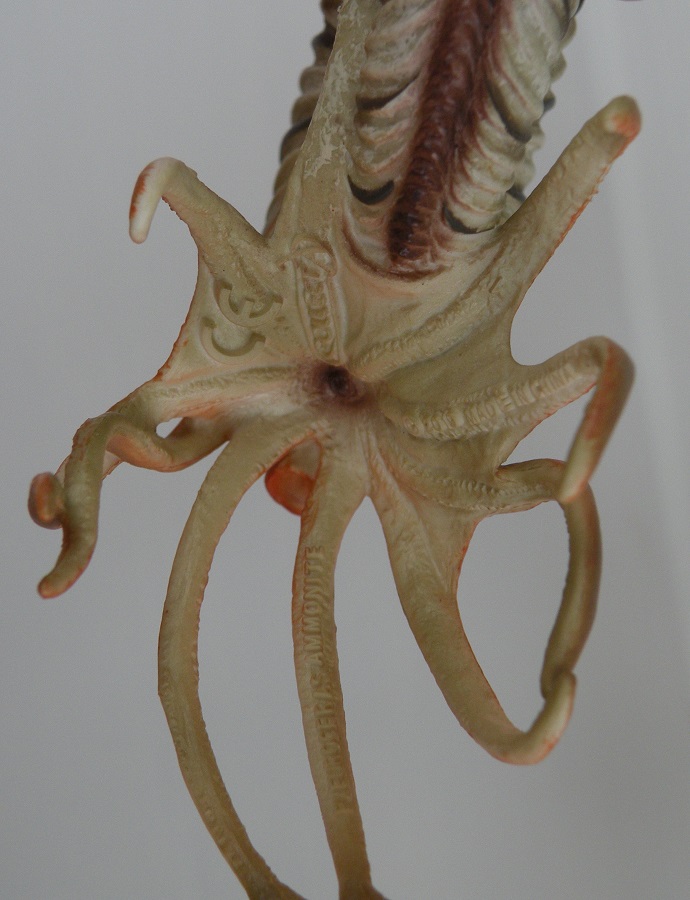
This ammonite has 8 arms splayed out in various directions and sculpted as various lengths, which given their boneless, muscular nature, it would have been possible for them to vary the length depending on what they were doing. It is also believed that ammonites could retract into their shell, which extant Nautiloids cannot do. One of the arms is attached to the shell, and two others cross over each other which is aesthetically interesting to look at. There isn’t much detail sculpted on the arms of this figure, but it is on the arms where the manufacturing information is, which I’m not excited about, but I guess that information had to go somewhere. Small suckers can be seen sculpted on the tentacular clubs.

The small beak can be seen sculpted within the radiating arms and tentacles, the two yellow eyes have been given rounded pupils, and there is a funnel sculpted on the underside. The shell is accurately sculpted with a ridged texture thanks to the radial ribs and tubercles along the shell’s circumference. The model is unable to stand on its own, but I find this preferable to sculpting a base onto it.
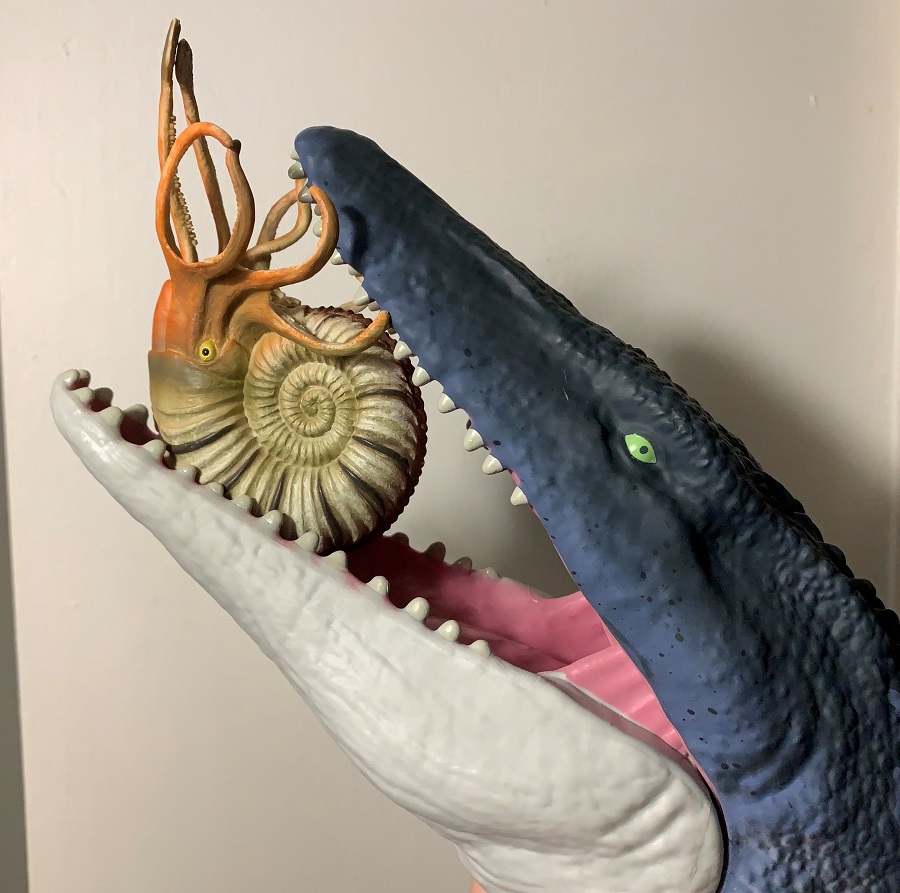
The soft portion of the body is reddish orange like that seen on extant giant and colossal squids. The inside of the arms and tentacles are unpainted, sharing the same color as most of the shell. The arm that is attached to the shell isn’t painted at all, and much of the first arm on the left side is also unpainted. The shell itself is an off-white, dirty gray color, with some brown bands around the outer whorl. The tubercles around the shell are another shade of brown, as is the portion around the shell opening.
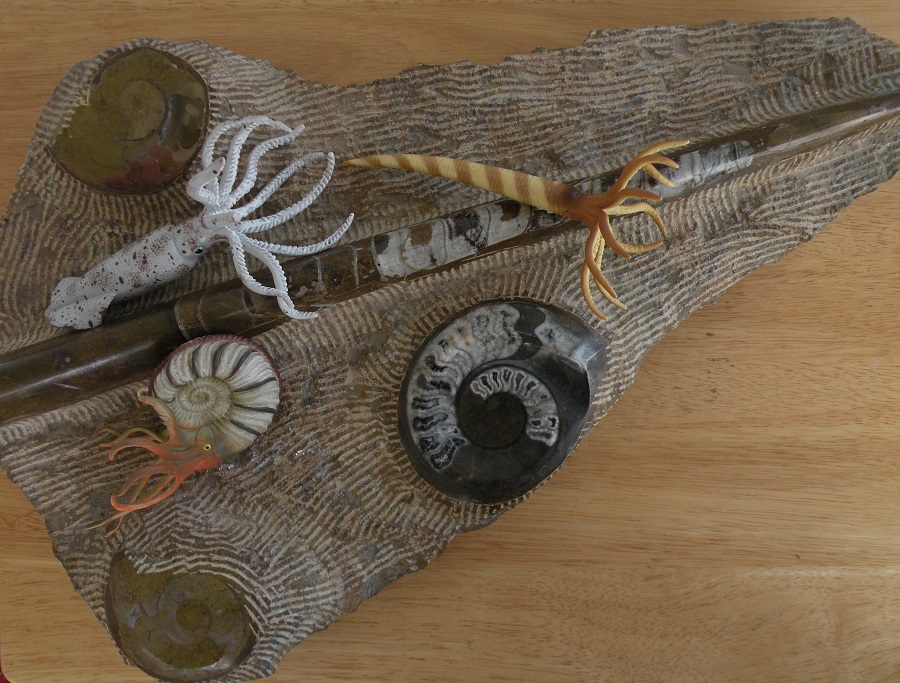
My only quibbles with this figure are the unfinished looking paintjob and the lack of detail on the arms in lieu of the manufacturing information. Aside from that this is an otherwise beautiful piece and, for me at least, the best ammonite figure to date. The sculpt is about as dynamic as you could expect an ammonite to be and the paintjob is subtle and naturalistic. For anyone looking to diversify their prehistoric animal collection or wanting to display an ammonite reconstruction next to their fossils perhaps, this is a must have. Support CollectA in their quest to produce prehistoric invertebrate figures and hopefully they reward us with more in the future.
Support the Dinosaur Toy Blog by making dino-purchases through these links to Ebay and Amazon. Disclaimer: links to Ebay.com and Amazon.com on the Dinosaur Toy Blog are often affiliate links, when you make purchases through these links we may make a commission

Excellent review and a good model. I just wish it was easier to display – for me, the fact that it won’t stand unaided and I have to resort to blu-tak or a wall to keep it upright is a bit of a disappointment.
Absolutely love this figure, looks so much more realistic that others. I have it displayed with my ammonites fossil.
Great review!
Thank you! I currently have it displayed with my other figures but am considering moving it to my fossil cabinet, I think it would look better there.
Wonderful! A little big for my tastes, but wonderful.
Magnificent and detailed article on the pleuroceras belemnite.
Great review of a great toy. Between this, the CollectA mini ammonites, and Kaiyodo’s ammonites, a very sketchy biostratigraphy of the Mesozoic is beginning to take shape! I hope the invertebrate offerings continue, whether mollusk, arthropod, echinoderm…
Great review. Although for 2022, I’d love to see CollectA produce a nice big sea scorpion like Pterygotus rather than a third ammonite.